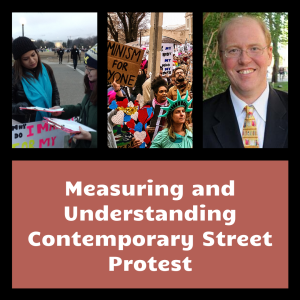Measuring and Understanding Contemporary Street Protest


How do we study protest? What components are available to measure, how do we measure them, and what does it all mean?
IRWG research professor Michael T. Heaney recently co-authored an article titled, "The science of contemporary street protest: New efforts in the United States," for the journal Science Advances. In it, the authors review methods for studying street protest and assess recent projects, including Heaney's own IRWG-supported study.
The authors explain, “In a time of sharp political polarization, protest is a notable way that citizens attempt to communicate their views on key issues. Protest is partly a response to citizens’ concerns that they are not being represented well by governmental institutions. As a result, it is important to understand the nature of, and messages conveyed by, protests.”
One way of studying protest on a large scale is to collect and measure event data. The authors review two types of measurements: event counting (how many events are organized, and how many people attended), and crowd surveys.
Professor Heaney’s research project includes in-person surveys of protest participants, at multiple protest sites with differing ideological perspectives, across time and physical location. Crowd surveys, the authors argue, “make it possible to understand. . .heterogeneity in terms of participants’ demographics, attitudes, political engagement, connections to social movement organizations, and more.”
The article concludes by assessing current methods for studying protest, including strengths and limitations, and offers recommendations for best practices in future research. They conclude, “In the middle of a period of heightened protest, collecting and analyzing high-quality data on protest and making it publicly available have special significance. The first 2 1/2 years of the Trump presidency witnessed a surge of social mobilization, with most of it focused on challenging President Trump, his statements, and his administration’s policies. . .this moment provides an opportunity to understand the groundswell of civic participation and activism, as well as its public impact, while simultaneously offering scholars the chance to hone further and deepen the scholarly tools available for such research—especially in terms of event counting and protest surveys.”
Read the full article here: https://advances.sciencemag.org/content/5/10/eaaw5461
